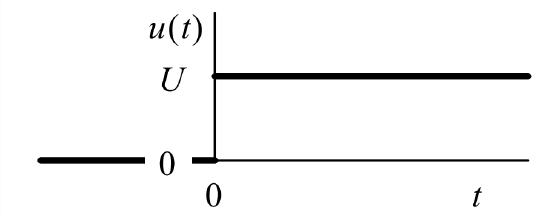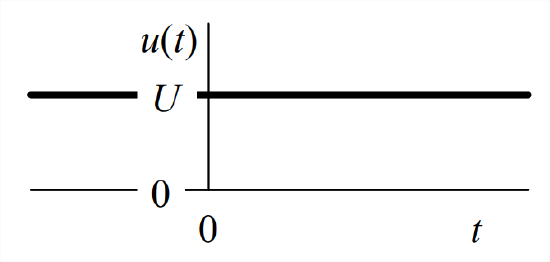7.4: Discussion of Physical Applicability of Step-Response Solutions
- Page ID
- 7666
The concept of step response in physical applications can be bothersome if one harbors the misconception that step response is valid only if the input is applied in an abrupt, discontinuous manner, as on the drawing at left. This misconception is natural and honest because of the mathematical definition of the step function, Equation 2.4.1 and Figure 2.4.1. If we apply that strict definition to the step input analyzed in Section 7.3, without any recognition of the nature of the initial conditions, then the time history of the input would have to be a discontinuous step function.

However, it is instructive to consider also the role of initial conditions in step response. Step response solution Equation 7.3.8 is derived for zero ICs, \(x_{0}=0\) and \(\dot{x}_{0}=0\). Imagine that some powerful external agent enforces these ICs for time \(t\) < 0, then at \(t\) = 0, the external agent abruptly releases its hold on the system. Under this circumstance, it does not matter whether the input \(u(t)\) jumps discontinuously from 0 to \(U\) at \(t\) = 0, as in the drawing above, or the input has value \(U\) both after and before \(t\) = 0, as in the drawing at left. An input value of \(U\) before \(t\) = 0 could not produce any effect on output \(x(t)\), because it could not overpower the external agent that enforces the initial conditions before and right up to the instant \(t\) = 0. A practical example to which we can relate is an airplane sitting on a runway, preparing to taxi for takeoff. With the brakes firmly engaged, the pilot increases engine thrust, but the airplane is held motionless by the brakes. In this example, the brakes play the role of “powerful external agent” that enforces the initial position and zero initial velocity, and the engine thrust plays the role of input quantity. After engine thrust has reached acceptable takeoff level, the pilot releases the brakes (at \(t\) = 0), and the airplane accelerates into takeoff taxi. The engine thrust exists before \(t\) = 0, but it produces no taxiing motion then because the brakes completely restrain the airplane.

The conclusion of this discussion is that step response is a valid physical solution even if the input is constant before and after the initiation of motion (i.e., is not applied strictly like a mathematical step function), provided that initial conditions enforce the motion prior to the instant (usually \(t\) = 0) when the input becomes effective.


